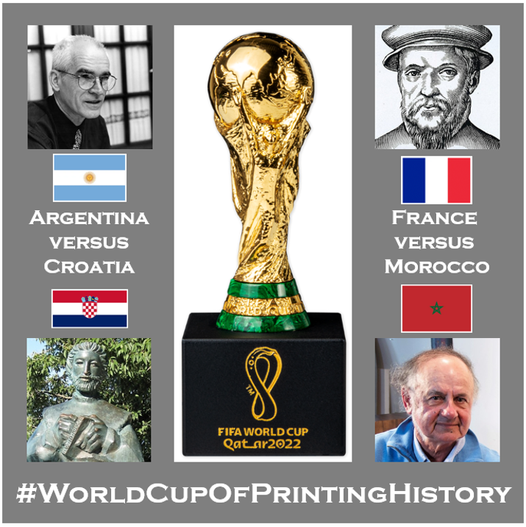By Jim Hamilton
You may not be familiar with the name Rubén Fontana, but he is the most recent winner of the World Cup of Printing History. Fontana, an Argentinian graphic designer, type designer, and teacher, was chosen to represent Argentina by the Museum of Printing in Haverhill, Massachusetts, the sponsor of the World Cup of Printing History.
In this social media competition, Fontana surged to the top (with a little help from Lionel Messi) when Argentina defeated France on penalty kicks in the 2022 FIFA World Cup final in Qatar. Fontana, born in 1942, outpaced France’s Claude Garamond (1480-1561), the famous type designer, publisher, and punch-cutter.

Figure 1: Argentina Outpaces France in the World Cup of Printing History
#WorldCupofPrintingHistory
So what is the World Cup of Printing History? It’s a social media campaign first created for the 2018 men’s World Cup. You can get a feel for it by searching the hashtag #WorldCupofPrintingHistory. The basic concept is to promote printing history by highlighting facts related to each country playing in the World Cup. The Museum hoped to benefit from the excitement around the World Cup to generate a little positive buzz and to inspire folks to visit (the Museum is about 45 -minutes north of Boston).
In the beginning, it was clear that for some countries, finding historical facts about printing would be easy. For others, it presented a bit of a research challenge. Further adding to the difficulty, some countries with rich printing histories were either not in the tournament (the United States did not qualify) or eliminated very early on (like Germany).
In the 2018 World Cup final, France met Croatia, with France winning 4 to 2. The fact chosen for the World Cup final (France versus Croatia on July 15, 2018) was about the book ‘Mirouer of the Redemption of the Human Lineage’ (1478), printed in Lyon by Martin Husz. This was the first French book with illustrations in the text. (Thanks to the Musée de l’Imprimerie in Lyon, France, for providing this fact.)
FIFA Women’s World Cup 2019, France
The Museum continued the #WorldCupofPrintingHistory social media campaign for the women’s World Cup in 2019. This time, the focus was exclusively on the role of women in printing history. Twelve teams made it through the group stage, each represented by a woman for the World Cup of Printing History. The women’s World Cup final matched the Netherlands versus the United States. Examples of the women representing the Netherlands and the United States were:
- Mary K. Goddard (1738-1816) conducted her family’s printing business in Baltimore from 1774 to 1784 and served as Baltimore’s postmaster from 1775 to 1789. In 1777, she was chosen to produce an authentic copy of the Declaration of Independence.
- Judith Rosanes (?-1805), great-granddaughter of a well-known Amsterdam printer, established a printing business in 1782 in Lemberg, Poland and had 24 employees (all male).
In the final, the U.S. women defeated the Netherlands by a 2-0 score. Hooray for Mary K. Goddard!
FIFA Men’s World Cup 2022, Qatar
The selections of facts and individuals for the World Cup of Printing History have been unscientific, though the Museum did seek suggestions as often as possible. One key aspect for social media was that each fact or person needed an image to go along with it. It was often hard to find images for some early — and fairly obscure — printers. In these cases, the Museum opted to seek more modern examples. Type designers, graphic designers, and printmakers proved to be excellent options. Also, it’s true that the history of early printing in some countries is dominated by colonizers or missionaries. For the 2022 World Cup, the Museum tried to avoid those stories and sought out ones that better represented the people of those countries. This is why some countries are represented by people who died hundreds of years ago while others have a living representative.
FIFA Women’s World Cup 2023, Australia and New Zealand (July 20 to August 20, 2023)
The World Cup of Printing History will be back again for the 2023 Women’s World Cup, which will take place soon. Thirty-two countries have qualified. This is up from twenty-four in 2019, so a nua number of countries are participating for the first time.
The Bottom Line
If you have ideas for women from printing history who should represent the countries who have qualified for the 2023 Women’s World Cup of Printing History, the Museum would love to hear from you. Please send your suggestion to jim@greenharbor.com.
Here is a list of the qualifiers: Argentina, Australia (co-host), Brazil, Canada, China, Colombia, Costa Rica, Denmark, England, France, Germany, Italy, Ireland, Jamaica, Japan, Morocco (debut), Netherlands, New Zealand (co-host), Nigeria, Norway, Philippines (debut), South Africa, South Korea, Spain, Sweden, Switzerland, United States, Vietnam (debut), and Zambia (debut).
Jim Hamilton, Consultant Emeritus at Keypoint Intelligence
Jim Hamilton of Green Harbor Publications is an industry analyst, market researcher, writer, and public speaker. For many years, he was Group Director in charge of Keypoint Intelligence’s (formerly InfoTrends’) Production Digital Printing & Publishing consulting services. He has a BA in German from Amherst College and a Master’s in Printing Technology from the Rochester Institute of Technology.


